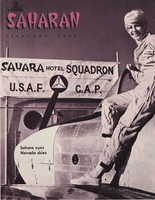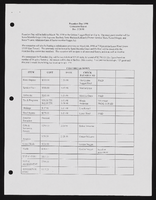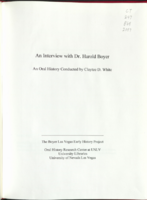Search the Special Collections and Archives Portal
Search Results

Transcript of interview with Joan Johnson by Kim Geary, March 25, 1978
Date
Archival Collection
Description
On March 25, 1978, Kim Geary interviewed Joan Johnson (born 1911 in Oklahoma) in her home in Las Vegas, Nevada. The two discuss Joan Johnson’s personal history and her reasons for originally moving to Las Vegas. Johnson recalls early Las Vegas entertainment, as well as the development of businesses and their unions.
Text

Transcript of interview with Carol Forsythe by Sam Copeland, March 2, 1977
Date
Archival Collection
Description
Text

Transcript of interview with Joe Burton by Bob Barrera, March 11, 1980
Date
Archival Collection
Description
Text

Transcript of interview with Perle Garrett by Marilyn Swanson, March 2, 1975
Date
Archival Collection
Description
On March 2, 1975, Marilyn Swanson interviewed her neighbor Perle Garrett (born April 27, 1905 in Overbrook, Kansas) in her home in Boulder City, Nevada. This interview covers Boulder City during the 1930s, with special focus on the building of Boulder Dam. Mrs. Garrett relocated to Boulder City because her husband Theodore Garrett was one of the workers at the dam. She also discusses Six Companies houses, family life, the weather, churches in Las Vegas and recreational activities for local children. Her husband is also present during the interview.
Text

Saharan Magazine from the Sahara Hotel and Casino, February 1966
Date
Archival Collection
Description
The February 1966 edition of The Saharan Magazine, a magazine created by the Sahara Hotel and Casino in Las Vegas, Nevada. Headlines in the magazine include: "Sahara Winder Lineup: Kinds and DeCastros", "Canadian Tops Winners in Sahara Anniversary", "Sahara Airlines Attendance Soars Over 6,000 Mark", "Sahara Becomes "Shooting Headquarters" in 1966", and "Thunderbird Cash Binge!"
Mixed Content
Lori Lipman Brown Papers
Identifier
Abstract
The Lori Lipman Brown Papers date from 1975 to 2009 and document former Nevada State Senator Lori Lipman Brown's political career. It includes correspondence and materials from Brown's service as a Nevada State Senator from 1992 to 1994, case files from her defamation lawsuit against Nevada State Senator Kathy Augustine, and papers from her work opposing the Nevada Question 2 ballot measure on same-sex marriage in 2000. The collection also contains photocopies of biographical materials and personal and publicity photographs of Brown, as well as material from her time working with local high school and commmunity theatre programs.
Archival Collection
Margot Mink Colbert Papers
Identifier
Abstract
The Margot Mink Colbert Papers (approximately 1959-2018) are comprised of materials that represent Colbert's career as a professional dancer, choreographer, and instructor. The materials span Colbert's career as a dancer in New York City at The Juilliard School, instructor at the University of Wisconsin-Madison, and instructor at the University of Nevada, Las Vegas. The materials in this collection also document Colbert's teaching career as well as her professional studio Ballet Mink. The materials include press and promotional materials about performances choreographed by Colbert within the United States as well as other countries including Russia and Denmark. The collection also include recordings of Colbert's choreographed performances.
Archival Collection
Aplin Family Scrapbooks
Identifier
Abstract
The Aplin Family Scrapbooks (1927-1971) consists of four handmade scrapbooks compiled by Hilda Aplin. The scrapbooks contain photographs, correspondence, newspaper clippings, and handwritten captions. The majority of the collection focuses on Hilda and Charles Aplin’s involvement in the Fraternal Order of Eagles and Las Vegas Eagles Auxiliary #1213. Also included is a photograph album that details the family’s activities from 1927 to 1959, including notable locations around Las Vegas, Nevada such as Lake Mead, Hoover Dam, Mt. Charleston, and annual Helldorado parades.
Archival Collection

Alpha Kappa Alpha Sorority, Theta Theta Omega Chapter Founders Day committee reports
Date
Archival Collection
Description
From the Alpha Kappa Alpha Sorority, Incorporated, Theta Theta Omega Chapter Records (MS-01014) -- Chapter records file.
Text

Transcript of interview with Dr. Harold Boyer by Claytee D. White, November 15, 2000
Date
Archival Collection
Description
Text
